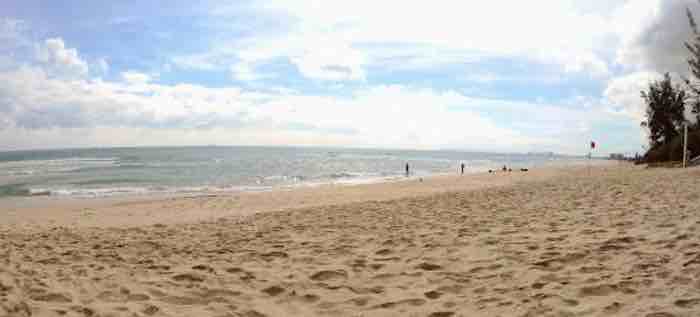Honestly, could there be any shortage of useful sand anywhere, anytime?
Sand on the Beach

Have you noticed yet?
Sand is In!
Apart from the fact that my friends and I are going on annual trips to the environs of “Sandy Lake” in Ontario, or that all the natural gas/oil “fracking” (causing and keeping open miniscule underground fissures) consumes a lot of fine sand to keep the underground rock fissures open, or its use in producing cement mix than can be troweled into smooth surfaces, or in the playground of your children or grandchildren, sand is one of those natural things that are truly plentiful and -- amazing.
Walking along miles of clean sandy ocean shores can be refreshing – or boring – depending on your state of mind. For some it’s like heaven on earth, for others a drudgery to be forgotten. Between the ocean on one side, sand in the center, dunes and mangroves on the other, not much activity happening, just a few swells of ocean surf.
Above all, the fine-grained sand is everywhere – between your toesies, on your fingers, in your shoes, on your clothes. Clearly, there appears to be an unlimited supply of it along many shorelines. But that’s not all. All the great deserts on earth, like the Sahara contain vast areas of that stuff. Even those “minor” deserts, like the Sonoran (in Arizona) or Mojave (in California) deserts contain gazillions of sand corns.
Honestly, could there be any shortage of useful sand anywhere, anytime?
The Sandman cometh
The Danish poet Hans Christian Anderson (1805-1875) wrote many poems and fairy tales. His children’s bedtime poem about “
little sandman” (Sandmännchen) has been a favorite for a century and still is to this day.
The poet Anderson probably did not have the process of fracking or any volcanic emissions in mind when he penned that story but sand is of interest for both. The former consumes it and the latter produces it -- with some help from the Moon and the Sun.
Yes, you can blame the Moon for that stuff between your toes!
And it comes in various “shades of grey.” Actually, I’ve seen shores with nearly black sand and others with absolutely white sand. What’s their difference?
Colors of Sand
The colors of natural sand, like of other things in nature can be quite varied. Just think of the bright red, blue, or green colors of Amazonian tree frogs. In the tropical oceans, the colors of the organisms are even more varied. From deep black coral to bright pink coral, there is no color and hue without some examples.
Most (dry) sand is of beige to orange-red color and consists largely of quartz and calcite with smaller amounts of other minerals like the iron-ore minerals magnetite and ilmenite. Their surfaces are often oxidized to produce thin layers of “rust” that gives them that color. From a few feet away, those “specks of rust” (and other embedded materials like red garnet crystals) together with the surrounding nearly white quartz corns produce a common visually light brown appearance of the sand. So, where do you find black sand?
Black Sand
In areas of this continent’s Granite Shield with its thousands of small lakes, one can find small beaches of nearly black sand deposits. That material consists largely of the afore-mentioned iron-ore type minerals, amphiboles, garnets, and other dark and – most importantly – heavier, i.e. denser mineral kernels. With just the right wave action and longshore current, much of the less dense quartz and feldspar spheres were sifted out by natural wave action. The photo shows a sample from near our place in the boonies; I have jars full of it.

Black sand on white paper, approximate frame size 3x5“ (8x12 cm), photo by author.
Most of the particles in the photo are (my guess) in the order of 1/00 of one inch in size. Some of the minerals in that (like Magnetite) are magnetic and, therefore can easily be separated out by placing a magnet beneath the paper and moving it around. Of the sample shown, perhaps 5% of the “sand corns” can so be separated out.
Other types of black beaches are found on the shores of land masses with volcanic origin. They are known from Hawaii, New Zealand, Iceland, the Canary Islands and many other localities. Their material is ground lava, a kind of solidified glass-like substance.
In other areas of the world, sand on the beach is much brighter, perhaps nearly white.
White Sand
The whitest white sand I’ve ever come across was along the shores of the Florida Panhandle, near Pensacola; the sand there is really snow-white. It doesn’t even show a tinge of yellow or red. Even a
Russian language website says so. Now, the local ordinances take care of maintaining it in that state by regularly sweeping it with machinery that picks up various kinds of flotsam and litter that shows up but even with some kelp on its surface, I think it still would be another “ HYPERLINK "https://en.wikipedia.org/wiki/Wonders_of_the_World" Wonder of the World.” This
white sand is composed of 99.9+ % quartz.
Of course, quartz is a common mineral. Its chemical composition is silicon- (more correctly termed silicium-) dioxide (SiO2). As the element Si is one of the most common in the earth’s crust, that fact ought to be no surprise. Clear quartz crystals are sought after by collectors. In NY State you can find extremely clear examples, commonly known as “Herkimer diamonds”. In the European Alps, they are known as “Bergkristall” (mountain crystal) and in Brazil you may find large voids with the inside covered with a blue to violet color variety, commonly available as the gemstone Amethyst.
Certainly, the world has plenty of sand but it’s not always were you need it. So, cherish the sand as you stroll along the beach.
Dr. Klaus L.E. Kaiser -- Bio and
Archives |
Comments
Dr. Klaus L.E. Kaiser is author of CONVENIENT MYTHS, the green revolution – perceptions, politics, and facts Convenient Myths

 Have you noticed yet?
Sand is In!
Apart from the fact that my friends and I are going on annual trips to the environs of “Sandy Lake” in Ontario, or that all the natural gas/oil “fracking” (causing and keeping open miniscule underground fissures) consumes a lot of fine sand to keep the underground rock fissures open, or its use in producing cement mix than can be troweled into smooth surfaces, or in the playground of your children or grandchildren, sand is one of those natural things that are truly plentiful and -- amazing.
Have you noticed yet?
Sand is In!
Apart from the fact that my friends and I are going on annual trips to the environs of “Sandy Lake” in Ontario, or that all the natural gas/oil “fracking” (causing and keeping open miniscule underground fissures) consumes a lot of fine sand to keep the underground rock fissures open, or its use in producing cement mix than can be troweled into smooth surfaces, or in the playground of your children or grandchildren, sand is one of those natural things that are truly plentiful and -- amazing.  Black sand on white paper, approximate frame size 3x5“ (8x12 cm), photo by author.
Most of the particles in the photo are (my guess) in the order of 1/00 of one inch in size. Some of the minerals in that (like Magnetite) are magnetic and, therefore can easily be separated out by placing a magnet beneath the paper and moving it around. Of the sample shown, perhaps 5% of the “sand corns” can so be separated out.
Other types of black beaches are found on the shores of land masses with volcanic origin. They are known from Hawaii, New Zealand, Iceland, the Canary Islands and many other localities. Their material is ground lava, a kind of solidified glass-like substance.
In other areas of the world, sand on the beach is much brighter, perhaps nearly white.
Black sand on white paper, approximate frame size 3x5“ (8x12 cm), photo by author.
Most of the particles in the photo are (my guess) in the order of 1/00 of one inch in size. Some of the minerals in that (like Magnetite) are magnetic and, therefore can easily be separated out by placing a magnet beneath the paper and moving it around. Of the sample shown, perhaps 5% of the “sand corns” can so be separated out.
Other types of black beaches are found on the shores of land masses with volcanic origin. They are known from Hawaii, New Zealand, Iceland, the Canary Islands and many other localities. Their material is ground lava, a kind of solidified glass-like substance.
In other areas of the world, sand on the beach is much brighter, perhaps nearly white.